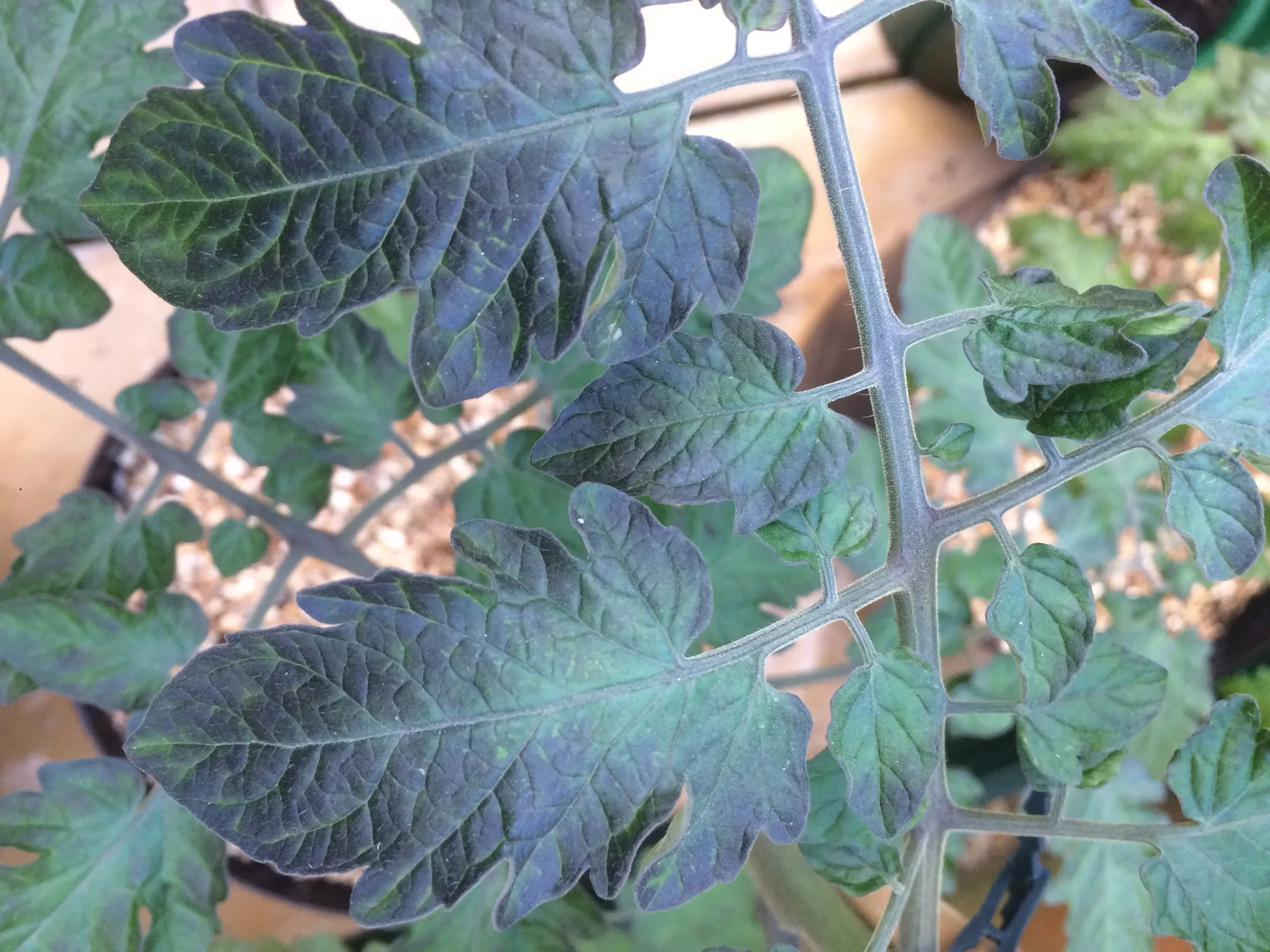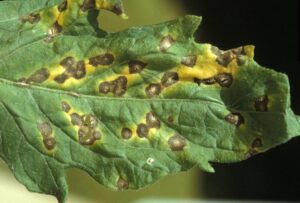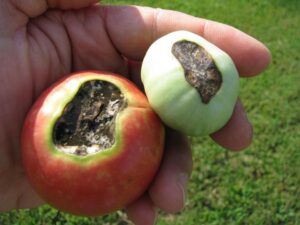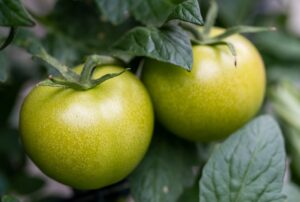Some tomato varieties bear purple fruit instead of red, while others, like Indigo Rose, also have purple-hued leaves. The color variant is a beautiful and natural characteristic of these cultivars. But if you find that once green tomato leaves are turning purple, it can be a sign there is a problem.
What causes green leaves to turn purple? In this article, you will learn six of the most common reasons and what you can do to remedy the problem.
6 Reasons Tomato Leaves Turn Purple and How to Treat Each Condition
1. Potassium Deficiency
Potassium is one of three macronutrients that are essential for healthy plant growth. For example, potassium plays an important role in photosynthesis, the process by which energy from the sun is converted for the plant’s use. In addition, potassium helps the plant process sugars and starches and is responsible for flower and fruit development. It also helps strengthen stems, stalks, and roots, and enables a plant’s ability to endure environmental stress.
A potassium deficiency can result in yellow leaf margins with purple veining. The lack of this important nutrient will eventually stunt plant growth and adversely affects flower and fruit production.
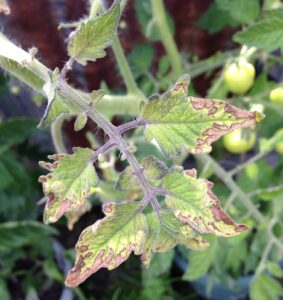
This article contains affiliate links. If you make a purchase using one of these links, I will receive a very small commission at no additional cost to you, and it will help me maintain this website. Rest assured, I only recommend products I actually like!
Treatment
Before you amend the soil, it is a good idea to perform a test to help you diagnose any deficiencies. Here is the soil test I use.
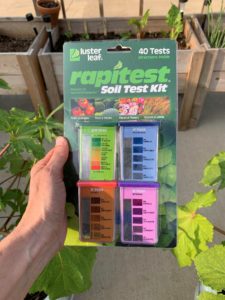
If there is indeed a potassium deficiency, you can add a fertilizer that is high in potassium. You can determine which fertilizer is higher in potassium by looking at the third number in the NPK (nitrogen, phosphorus, potassium) ratio. (You can learn more about NPK in this helpful article.) A liquid fertilizer will act quicker than a granular one.
There are other means of increasing available potassium. For example, you can add wood ash, kelp, greensand (glauconite, a mineral mined from the ocean) and gypsum. Keep in mind, however, that these amendments release potassium into the soil more slowly.
Another aspect to consider is that there may be adequate potassium available in the soil, but cool soil temperatures are preventing the plant’s uptake. We’ll look at soil temperature as the culprit later in this article.
2. Phosphorus Deficiency
Phosphorus, another one of the macronutrients, is a must for plant vigor. It promotes root development, which is especially important in root crops like carrots, beets, turnips, and sweet potatoes. Additionally, this nutrient is responsible for seed formation and flower and fruit production.
A deficiency of this vital nutrient will turn leaves a darker green. The underside of the leaf or the leaf veins will also turn somewhat purple. Moreover, leaves may curl and/or develop spots or necrosis, usually on older leaves. (Learn the top ten causes for tomato leaf curl in this helpful article.) Ultimately, plant growth will be stunted, and flower and fruit production delayed.
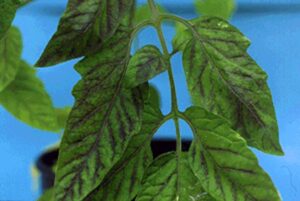
Treatment
Again, be sure to perform a soil test before you make any adjustments. If there is a phosphorus deficiency, you can remedy the problem by using a fertilizer high in phosphorus (the second number in the NPK ratio.) Bone meal is an effective and quick way to add phosphorus. In addition, rock phosphate is an option, but it is released into the soil more slowly than bone meal.
Just as in a potassium deficiency, the problem may not be that the soil is lacking this vital nutrient, but rather, it is not warm enough for the plant to absorb it. Moreover, if the soil pH is too acidic or too alkaline, it will prevent the plant from taking up phosphorus and other nutrients.
3. Magnesium Deficiency
Magnesium is a secondary macronutrient. It is a component found in chlorophyll. Like potassium, magnesium is essential for photosynthesis. It also encourages flowers to set fruit, and it enables a plant to take up nutrients from the soil.
If there is a magnesium deficiency, there will also be a chlorophyl deficiency, which will result in the yellowing of leaf tissue located in between leaf veins in older leaves. This is because magnesium is mobile. As the plant redirects available magnesium to newer growth, the older growth becomes deficient and discolored. As the problem progresses, yellowing will spread to other leaves, and you may also see red, brown, and purple hues. (You can learn more about magnesium deficiency in this helpful article.)
Treatment
Address magnesium deficiency by adding magnesium sulfate, also known as Epsom salt, to the soil. Recommended dosing is one tablespoon of Epsom salt per half gallon of water. Use the solution as a foliar spray once or twice a month until the problem is resolved. This is the sprayer I use.
4. Cold Soil
Soil temperature plays an important role in a plant’s life, especially when it is young. (Learn more about the importance of soil temperature in this helpful article.) If the soil is too cold, typically 60 F (15 C) and below, seedlings will not be able to take up essential nutrients, resulting in yellow or purple leaves.
Treatment
The problem will resolve on its own when soil temperature increases. Note, however, that plant growth may be stunted as a result. To avoid this problem altogether, try planting seeds or seedlings when the soil temperature has warmed. You can use a soil thermometer to check the temperature.
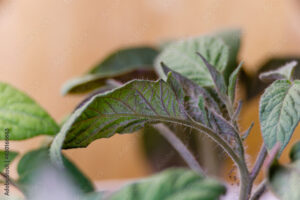
5. Overexposure to Light
Another issue that affects tomato seedlings in particular, is when the new plants are too close to grow lights or if they receive too much direct sun. Leaves can turn red or purple as a result.
Treatment
Adjust the height of the grow light to create more distance between the light and the top of the seedling. If outside, try to limit the plant’s exposure to intense sunlight by using a row cover, or if the plant is in a pot, relocate it temporarily to an area with some afternoon shade.
6. Viruses
Some plant viruses can cause tomato leaves to turn purple. Here are some examples:
Curly Top Virus results in leaves that twist, curl, and have yellow or purple spots. They can also develop purple veining.
Tomato Leaf Curl causes leaf cupping as well as leaf edges to turn yellow while the veins on the underside of the leaf appear purple.
Tomato Spotted Wilt Virus causes leaf spots that are bronze or dark brown or have prominent purple veining.
Tomato Purple Leaf Disorder usually appears on the upper surface of leaves and does not involve the leaf veins. The disorder will eventually spread to the entire surface of the leaf. At this point, the cause of the disorder is unknown, but it is thought to be viral in nature.
Treatment
Some pests can transmit tomato viruses. One of the best ways to prevent and control these viruses is to control the pests that transmit them.
Leafhoppers can be vectors for curly top virus. There are a variety of treatment options available.
Whiteflies can be vectors of Tomato Leaf Curl, so it is important to control this pest.
Thrips have been known to carry Tomato Spotted Wilt Virus. Here are treatment options for thrips, but if Tomato Spotted Wilt Virus is confirmed, you need to remove and destroy the infected plants.
Now that you know the top six reasons why tomato leaves turn purple, you can be on the lookout for the phenomenon in your garden and be prepared to take action right away.
Thank you for reading this article! If you found it interesting or helpful, please consider sharing it with others via email and social media!
